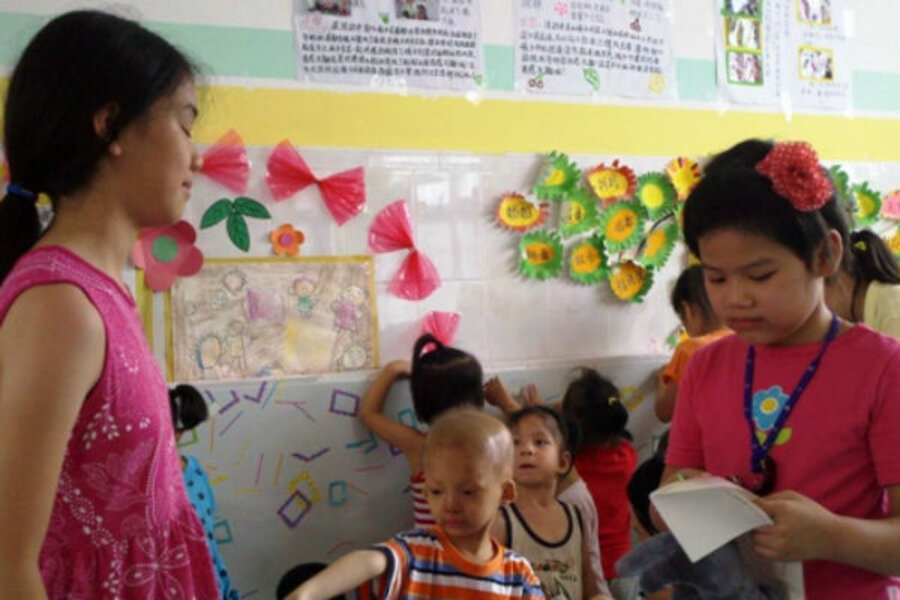China adoption diary: A many-Kleenex visit to Grace’s orphanage
Loading...
| Guangzhou, Garden Hotel, June 21
Part 7 of Gretchen Belsie’s account of her trip with husband Laurent and their first adopted Chinese daughter – 10-year-old Grace – as they head to meet and bring home 7-year-old Madeleine Bao Yi.
As we were having breakfast in Maoming this morning, I kept a close eye on Grace, checking to see how she was gearing up for the day’s activity. Back in May, she, Laurent, and I discussed at length what it would mean to take this opportunity to return to her orphanage. Grace made the final decision, and we figured the trip into our itinerary.
She was unusually quiet and pensive at the table while Bao Yi was happily feasting on mini corn cobs steamed in milk, steamed dumplings, watermelon, and slices of ham.
The van ride to the orphanage was only 10 minutes, but it was a world away.
The van pulled into a small brick courtyard, which was surrounded by a six-story cement and steel building accented with pink tiles. Laundry was hanging over the iron railings and rust stains wept down the façade.
We were met by the vice director of the Maoming Social Welfare Institute, a very pleasant woman named Yin Lian Rong. She ushered us up to a conference room where we were able to ask questions, through translators, to our hearts’ content.
This particular orphanage – one of three in Maoming proper – is the one that takes in babies found abandoned within the city limits. A woman from the rural outskirts could potentially make it into the city and drop her baby at one of the commonly known “finding spots,” so there was no way to know if the baby was born in the city. We were able to see the original files and did learn that Grace had been found at the Zhan Qian gate in a certain city district.
Up to this point, we had not told Grace directly that she had been left outside in a box. She is a very sensitive girl, and the most we told her was that her Chinese mother turned her over so that she could be cared for and loved. Grace latched on to the word “abandoned” today and looked very startled. I handled it quickly, but as time goes on, she’ll put things together on her own and will make her peace with her past.
Adoption in China is changing, most notably with the lengthened wait for a healthy infant – now about 62 months from the time the dossier arrives in China and is logged in at the central office – and the move toward handling only special needs cases for international adoption. At this orphanage, which started in 1981, 60 percent of the children will be adopted, and 90 percent of them are special needs.
Because of the shift in the children’s profiles, the aunties are now each assigned to the care of only three babies whereas back in Grace’s day, an auntie could have the same 20 children in her charge for months on end. It was tough to see these children as their special needs were so pronounced. Seeing the aunties patiently interact with them and treat them with dignity was hard for me to see, but it was also necessary and rewarding.
We were on site for about 90 emotional minutes, and concluded the visit with some picture taking in the courtyard. Grace posed in a small grassy area, now surrounded by steel girders and unfinished construction, that used to be an open play yard back in her day. Through all the tour, both Grace and Bao Yi were attentive and unfazed, but it is something that they both may remember and reflect on in the years to come.
Bao Yi gave us all a big surprise en route when she took out a Hello Kitty drawing pad and started to copy the English alphabet from the front cover. She did this with confidence and pronounced the letters after a fashion.
We were floored.
Helen, our guide, said that children in some orphanages, especially in a place like Shenzhen City, are taught English as part of their coursework. If she knows her alphabet and numbers by September, we may send her to school and see how it goes. We got her to practice writing Massachusetts because she’ll need a running start for that.
I have run out of Kleenex myself and need to rest up for tomorrow’s trip to the Guangzhou zoo. Rain or shine, we’re on the hunt for some pandas.







